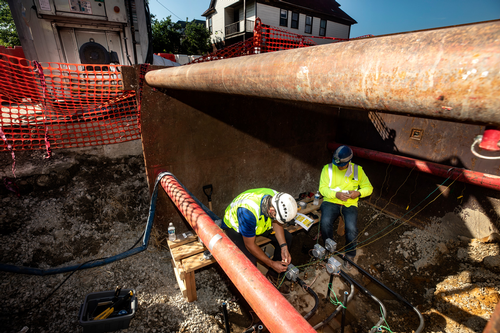TUESDAY, NOVEMBER 17, 2020
In an effort to extend the lifespan of water and sewer pipeline systems, researchers from the University of Michigan, in collaboration with the Great Lakes Water Authority and engineering firm Structural Technologies, are conducting a pilot project involving infrastructure sensors and innovative lining technologies.
“Our research focuses on finding cost effective ways to identify when aging infrastructure systems are showing signs of breakdown,” said Jerome Lynch, Chair of U-M’s Department of Civil and Environmental Engineering, and Director of the Laboratory of Intelligent Systems Technology. “If we can do that successfully, we’re able to identify distress before failure occurs.”
Lynch adds that the collected data aims to create more cost-effective intervention strategies.
The Research
Starting in June 2019, Detroit officials announced that they would be entering a five-year, $500 million replacement program, focused on water and sewer pipes throughout the city. The announcement arrived as the first major upgrade to the infrastructure in roughly 90 years.
However, Detroit isn’t the only city in need of a major overhaul. In fact, the American Society of Civil Engineers estimates the U.S. sees 240,000 water main breaks annually, wasting more than 2 trillion gallons of treated drinking water. The American Water Works Association has also calculated that over the next 25 years, as much as $1 trillion in funding for drinking water will be required to maintain current services and expand them as needed in the nation.

 |
| University of Michigan |
|
In an effort to extend the lifespan of water and sewer pipeline systems, researchers from the University of Michigan, in collaboration with the Great Lakes Water Authority and engineering firm Structural Technologies, are conducting a pilot project involving infrastructure sensors and innovative lining technologies. |
Starting back in August, GLWA crews installed a Structural Technologies-developed lining system inside a block-long section of pipeline a few miles east of Detroit’s main downtown area. Made of cast iron, the pipeline was originally installed in 1913 and is a prime example of what cities around the world are dealing with in terms of aging infrastructure.
The liner installed on the 107-year-old pipeline is made of both steel reinforced polymer and mortar composites, increasing the system’s structural capacity and durability.
In addition to the lining system, GLWA also worked with U-M advisors to install 17 channels that measure three factors:
While the pilot project is underway, the university reports that line replacement throughout the city—or any city for that matter—is a daunting task, as the action can be affected by service interruptions to traffic foul-ups caused by work along busy streets, or identifying problem areas in a large municipal system section that are key to infrastructure replacement when placed under a short timeline, among other things.
“GLWA is committed to innovation at all levels of the organization to ensure system reliability,” said John Norton, GLWA’s Director of Energy, Research and Innovation. “Pilots like this with the University of Michigan help us as we work to understand and address potential failures in our water distribution system before they occur.
“Our overarching goal is to understand and improve our ability to select the proper technologies so we can maintain, and even improve, the level of service we provide to the people we serve in southeast Michigan.”
Tagged categories: Colleges and Universities; Infrastructure; Linings; non-potable water; Pipelines; potable water; Quality Control; Research and development; Technology